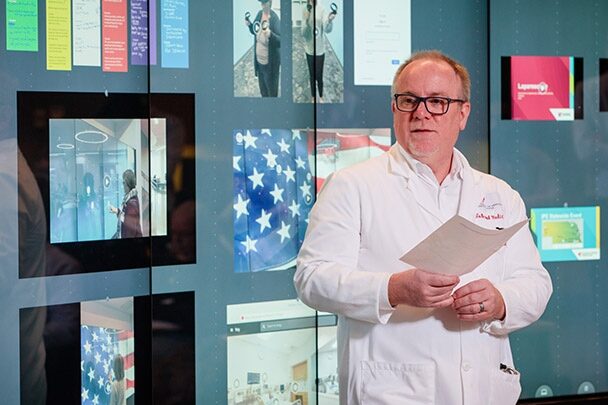Without fanfare or countdown, just an unceremonious flip of a switch was all it took to melt away 500 miles of the state and two time zones and suddenly the six statewide UNMC locations were connected for the first time via iWalls.
The statewide connection event was held by the interprofessional education program on Nov. 15, when faculty and students from Omaha, Lincoln (nursing and dentistry), Norfolk, Kearney and Scottsbluff shared ways in which they use the iWall to enhance medical education.
The session, moderated by Devin Nickol, M.D., associate professor and associate dean for interprofessional education, was the first attempt to demonstrate the interprofessional learning opportunities taking place across the state.
The iEXCEL program assisted the statewide connection through organizational and technical support. iEXCEL has been a key collaborator in the rollout and implementation of the iWall technology for training and outreach across Nebraska and other UNMC campuses.
Some campuses have already joined forces to hold joint classes. Sue Schuelke, Ph.D., assistant professor in the College of Nursing Lincoln Division, said cross campus training has been held between the four nursing campuses before Norfolk acquired the technology. Kearney also has used it for nursing and allied health interprofessional training across three campuses.
The hygiene program in Lincoln held real time classes with students in Scottsbluff. “We all worked together and didn’t feel hundreds of miles apart,” said Heather Hessheimer, assistant professor of dental hygiene.
Faculty members displayed their creativity of adapting the iWall to health education through use of video, simulation, virtual tours, games, file sharing and quizzes.
Challenges identified by the faculty include audio issues, inconsistent number of wall panels at different sites (Omaha 12 panels, Kearney six, Lincoln five), and the need to regulate the number of students who use the wall at the same time.
Dentistry and nursing in Lincoln have addressed the crowding issue by using different software to expand iWall use to several large monitors, or pods, in a classroom that can be accessed by small groups or to individual student laptops.
Dr. Nickol said he would like to explore the development of realistic interprofessional teaching scenarios using the iWall. “We could pilot a practical lesson on how health professionals could communicate handing off a patient who is being transferred from one city to another.”
The possibilities are endless — especially when time and distance don’t exist.

I would also like to acknowledge that faculty could not do any of these things without the tremendous support of the technical staff that provide the foundations of the technology to allow us to be creative in reaching our students. Thanks to all who participated in these endeavors.